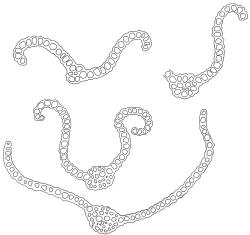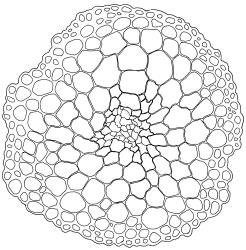- ≡ Pottia ceratodontea Müll.Hal., Syn. Musc. Frond. 1, 564 (1849)
- ≡ Didymodon ceratodonteus (Müll.Hal.) Dixon, Kongel. Norske Vidensk. Selsk. Skr. (Trondheim) 1932: 7 (1932)
- = Gymnostomum knightii Schimp. ex Knight, Trans. & Proc. New Zealand Inst. 7: 354 (1875)
Plants olive-green above, pale below, in dense turves or gregarious among other mosses. Stems 2–5 mm, branched, in cross-section with a central strand and well-developed sclerodermis. Leaves erect-spreading when moist, erect-incurved when dry, c. 1 mm, broadly lanceolate, concave (but lying flat under a cover-slip), and with lamina often loosely once plicate on one or both sides, rounded or broadly acute (especially in lower leaves), and weakly cucullate at apex; margins narrowly recurved, often from near base to near apex, unistratose, entire or papillose; upper laminal cells clear in outline, irregularly quadrate with rounded lumina or oblate (especially at the margin), thick-walled, obscurely or obviously papillose with 1–3 low rounded papillae, 9–13 × 9–10 µm, becoming longer towards the leaf base; lower laminal cells scarcely differentiated, firm-walled, not hyaline, smooth, quadrate to short-rectangular, shorter towards the leaf margins where several rows are ± quadrate to oblate. Costa concolorous, stout, failing c. 4–6 cells before leaf apex; adaxial superficial cells quadrate in distal ⅓; abaxial superficial cells quadrate to short-rectangular distally. Axillary hairs of 2–3(–5) cells, of which the basal cell is shorter and brown. Laminal KOH colour reaction yellow to yellow-orange.
Dioicous. Perichaetia terminal, becoming lateral through innovation, with inner perichaetial leaves loosely sheathing the seta base, basal laminal zone of smooth, longer, and irregularly rhombic cells extending to c. 4/5 the leaf length. Perigonia bulbiform on branching plants of similar size. Setae slender, dark red below, pale above, 4–8(–10) mm. Capsules erect, symmetric, short- or long-subcylindric, tapering slightly from near the base, 0.6–1.0(–1.5) mm. Operculum rostrate with an erect or oblique beak from a conical base, ½ to equal the theca length, with cells in straight rows. Peristome absent or vestigial and consisting of finely stippled, colourless fragments at capsule mouth. Calyptra cucullate. Spores (8–)11–17 µm, smooth.
Magill 1981, fig. 68, 11–19 (as Didymodon ceratodonteus); Zander 1993, pl. 50, 4–7 (as Didymodon ceratodonteus); Malcolm et al. 2020, pp. 518–519 (as Didymodon ceratodonteus).
Geheebia ceratodontea may be recognised by its broadly lanceolate leaves with rounded apices, failing costae and recurved margins. Leaf apices near the base of shoots, may be broadly acute. In the dry state the leaves are neither contorted nor twisted, but are erect and incurved.
Confusion is most likely with G. tophacea, but G. ceratodontea can be distinguished by its usually taller and more frequently branched habit, as well as the features given in the key. Distinctions from Tridontium cockaynei are given under that species.
A perceived likeness to the unrelated Ceratodon purpureus was noted in the protologue: "Ceratodonti purpureo primo adspectu similis, sed planta pottioidea" (Müller 1848–1849). The comparison is telling, given the frequency with which Ceratodon purpureus can be collected mistakenly for a member of the Pottiaceae. However, G. ceratodontea differs from typical Ceratodon purpureus in its entire, rounded leaf apices, failing costa, and papillose laminal cells. It also lacks the red coloration often seen in Ceratodon purpureus.
NI: N Auckland, including offshore island (RT), S Auckland, Gisborne, Hawke’s Bay, Wellington; SI: Nelson, Canterbury, Otago.
Known also from southern Africa.*
The species has been found on soil and on weathered rock, often calcareous (e.g., on midden material with shells, or on the soft blue-grey mudstone known regionally as papa). Sites are usually strongly insolated and modified, such as road- or track-side banks, but may also be sites of natural disturbance, such as sea-cliffs or stream-sides. Associated mosses include species of Barbula (B. calycina and B. unguiculata), Ceratodon purpureus, Fissidens leptocladus, Geheebia tophacea, Gertrudiella torquata, Gymnostomum calcareum, Streblotrichum convolutum, and Trichostomopsis australasiae.
Geheebia ceratodontea is a lowland moss, with most records coming from below 100 m elevation. The highest known so far is at 360 m, from Waikite Thermal Pools near Rotorua (J.E. Beever 47-19 & Z. Iwatsuki, CHR 611395, S Auckland L.D.).
Geheebia ceratodontea (as Didymodon ceratodonteus) was placed in synonymy of G. tophacea (as D. tophacea) on morphological grounds (Jiménez et al. 2005). The similarity of their tuber morphology had earlier led to speculation that G. ceratodontea (as D. ceratodonteus) might be merely a gymnostomous form of G. tophacea (Arts 1998, as D. tophaceus). Sainsbury (1955, pp. 179–180) had come to a similar conclusion, recognising two forms of Desmatodon lingulatus (Hook.f. & Wilson) Sainsbury, one of which was "gymnostomous or nearly so", and had several other significant differences from the "normal peristomate plant", which was "shorter, always unbranched, and with the leaves more broadly lingulate". After examining some 70 relevant specimens, the present author believes that two species are present, corresponding to the forms Sainsbury recognised, albeit the height of the shoots is not always a useful discriminator. Mixed colonies occur (e.g., Waikōwhai Domain, J.T. Linzey s.n., CHR 629131, N Auckland L.D.).
Sainsbury’s "gymnostomous form" is referable to the southern African Geheebia ceratodontea, based on examination of depauperate type material (Ecklon s.n., BM 000661401) as well as representative southern African specimens (e.g., J. van Rooy 3328, PRE 693595). The species is described and beautifully illustrated (as Didymodon ceratodonteus) in the Flora of Southern Africa (Magill 1981, pp. 233–235). There is a difference between southern African and N.Z. specimens in the frequency of acute leaf apices. These are much less frequent than are rounded apices in N.Z. specimens (and are usually confined to leaves low on the stem), whereas acute leaf apices are common in southern African material. Sainsbury’s "normal peristomate form" (e.g., Waihua, Hawke’s Bay, G.O.K. Sainsbury 16102, WELT M014284) is accepted in this treatment as Geheebia tophacea (Brid.) R.H.Zander.
Dixon (1923, p. 126) treated Gymnostomum knightii as a synonym of Didymodon lingulatus. He stated that "Knight’s plant in Herb. Hampe … [has] only old capsules … which show fragmentary traces of a peristome". He implied that these fragments were damaged remains of the well-developed peristome he observed in specimens of D. lingulatus. In holotype material of Gymnostomum knightii (WELT-Knight M044541) the present author has observed a vestigial peristome on a freshly deoperculate capsule, and no peristome on older (deoperculate) capsules, a pattern that can occur in Geheebia ceratodontea. In addition, the presence of quadrate superficial cells on the adaxial face of the costa in its distal third is evidence that correct synonymy is with G. ceratodontea rather than with G. tophacea.










